Vilnis ('The Wave') was a Lithuanian-language Bolshevik newspaper published from Riga 1913-1914 (weekly) and in 1917, issued by a group of Lithuanian socialists residing there. Vilnis was brought from Riga for distribution inside Lithuania. [1] [2] [3]

Riga is the capital, primate, and the largest city of Latvia as well as the most populous city in the Baltic States. Home to 609,489 inhabitants, the city accounts for a third of Latvia's total population. The population of Riga metropolitan area, which stretches beyond the city limits, is estimated at 860,142. The city lies on the Gulf of Riga at the mouth of the Daugava river where it meets the Baltic Sea. Riga's territory covers 307.17 km2 (118.60 sq mi) and lies 1–10 m (3–33 ft) above sea level on a flat and sandy plain.
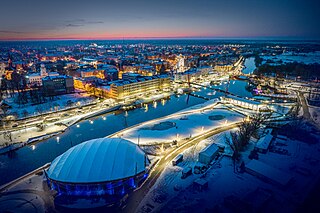
Jelgava is a state city in central Latvia about 41 kilometres southwest of Riga. It is the largest town in the region of Zemgale (Semigalia). Jelgava was the capital of the united Duchy of Courland and Semigallia (1578–1795) and the administrative center of the Courland Governorate (1795–1918).

Vincas Mickevičius, known under his pen name Kapsukas, was a Lithuanian communist political activist, publicist and revolutionary.

The West Russian Volunteer Army or Bermontians was a pro-German military formation in Latvia and Lithuania during the Russian Civil War in 1918–20.

Riga City Council is the government of the city of Riga, the capital of Latvia. Its meeting place is in the Riga Town Hall at the Town Hall Square (Rātslaukums) in the very heart of Riga.
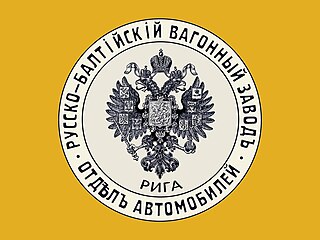
Russo-Balt was one of the first Russian companies that produced vehicles and aircraft between 1909 and 1923. Its successor is the luxury armored SUVs producer Dartz.
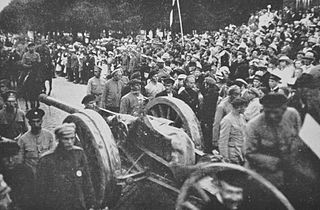
The Latvian War of Independence, sometimes called Latvia's freedom battles or the Latvian War of Liberation, was a series of military conflicts in Latvia between 5 December 1918, after the newly proclaimed Republic of Latvia was invaded by Soviet Russia, and the signing of the Latvian-Soviet Riga Peace Treaty on 11 August 1920.
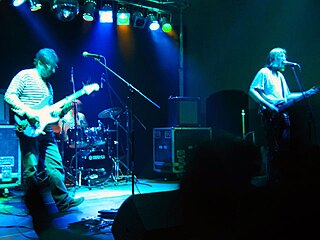
Dzeltenie Pastnieki are a Latvian band formed in 1979 in Riga, Latvia. Their name means "the yellow postmen" in Latvian, and is sometimes abbreviated to DzP. They were among the pioneers of new wave as well as reggae in the former Soviet Union. The music has ranged from guitar/bass/drums-based post-punk to minimal synthpop to experimental tape manipulation.
The Hobos are a Latvian rock group formed in 1999 by Rolands Ūdris (vocals), Mārtiņš Burkēvics, Egons Kronbergs (guitar) and Vilnis Krieviņš (drums). Their debut album was hailed by many prominent critics as the best thing to come out of Latvian music scene in the last decade.
Vilnis Straume was a former Latvian football player.

Hugo Celmiņš was a Latvian politician, a public employee, agronomist, twice the Prime Minister of Latvia. Arrested and deported to the USSR after the Soviet occupation of Latvia in 1940, imprisoned in Moscow's Lefortovo Prison. On 30 July 1941 shot and buried in the mass graves of Kommunarka shooting ground. Hugo Celmiņš was one of those who developed agrarian reform in Latvia.
The Twentieth Army Corps was a formation of the Imperial Russian Army that was first raised in 1899, and most famous for fighting on the Eastern Front in World War I, most notably during the Second Battle of the Masurian Lakes. Before World War I, the 20th Corps was stationed in the Vilna Military District with its headquarters in Riga. At the outbreak of the war, the corps consisted of two infantry divisions and a number of independent battalions and brigades. Many Lithuanians served in this unit with the 28th Division having particularly many Lithuanians, especially in the 109th and 111th Infantry Regiments. Some regiments in this Corps were 80% Latvian. The corps was demobilized in April 1917.
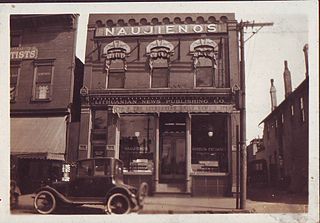
Naujienos with the English subtitle The Lithuanian Daily News was a Lithuanian-language socialist daily newspaper published from Chicago, United States. Established in February 1914, it became the first daily of the Lithuanian-Americans. After the October Revolution of 1917, the newspaper shifted its political orientation away from communism and socialism and towards social democracy. The newspaper helped to raise funds for Lituanica and Lituanica II, two transatlantic flights by Lithuanian pilots. As of 1960, it had a circulation of around 14,000. Pijus Grigaitis and Martynas Gudelis (1969–1986) were the long-time editors of the paper. Soon after Gudelis, the newspaper ceased publication.
Pranas Talzūnas was a Lithuanian American basketball player. He won a gold medal with the Lithuania national basketball team during the EuroBasket 1937, held in Riga. Pranas was named MVP of EuroBasket 1937 and is regarded as the first player to use the hook shot. Talzūnas attitude toward the game, the matches and the representing of the nation seriousness are perfectly described by his words after the successful competition ending: "I confess that going to Riga I had no clue what to thought: whenever we will win or not. I didn't knew how our upcoming opponents plays. <...> We won deservedly, however <...> it wasn't easy. <...> The concern of the upcoming battles for me and for Feliksas Kriaučiūnas didn't let us to sleep for any single night. <...> We were considering the victories possibilities for hours and still doubted it. Now everything is over. For me the heaviest stone just fall from the chest".
Vilnis ('Wave') was a Lithuanian language communist newspaper published from Chicago, the United States 1920–1989. The first issue was published on April 8, 1920, following the split the Socialist Party of America. The founder of Vilnis, Vincas Andrulis, became its editor.
Vilnis is the name of several Latvian and Lithuanian-language newspapers:

Videniškiai is a historic village in the Molėtai District Municipality, Lithuania. It is located about 8 kilometres (5.0 mi) west of Molėtai. It is situated between the Ukmergė–Molėtai road and the Siesartis River. According to the 2011 census, it had 368 residents. In the 16th–17th centuries, the village was one of the core properties of the Giedroyć family who funded the monastery for the Canons Regular of Penitence of the Blessed Martyrs and the Church of St. Lawrence. The monastery honored Michał Giedroyć who was possibly born in the village and was officially beatified in 2018. The reconstructed monastery now houses a small museum and a library.

The Lithuanian Art Society was a society that organized Lithuanian art exhibitions and supported Lithuanian artists. Based in Vilnius, it was active from 1907 to the outbreak of World War I in 1914. It was chaired by painter Antanas Žmuidzinavičius. The society was established after the first Lithuanian art exhibition was successfully organized in early 1907. The society continued to organize annual exhibitions that displayed works both by professional and folk artists. Influenced by the Arts and Crafts movement, the society paid great attention to Lithuanian folk art which was increasingly seen as an expression of the Lithuanian character. In 1912, the society published an album of drawings of Lithuanian crosses, column shrines, and roofed poles, which is considered the first study of Lithuanian folk art. The society was also instrumental in preserving the art of Mikalojus Konstantinas Čiurlionis and organized his first solo exhibitions in 1911 and 1913. The society also collected works by other artists and worked with the Lithuanian Scientific Society to establish a Lithuanian art museum. The collection was transferred to the present-day M. K. Čiurlionis National Art Museum in 1920.

Potencija Pinkauskaitė was a leading character actress of interwar Lithuanian theater, representative of the first generation of professional Lithuanian theater actors.

Augšdaugava Municipality is one of the 35 municipalities established in Latvia in 2021. It surrounds the independent city of Daugavpils and its municipal headquarters are located there. Its first elected municipal council has taken office on 1 July 2021.